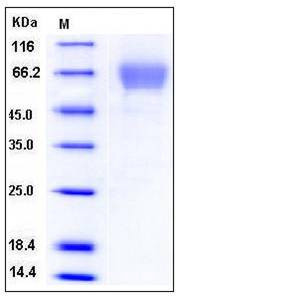Mouse TIM4 / TIMD4 Protein (His Tag)
B430010N18Rik,TIM-4,Tim4
- 100ug (NPP3509) Please inquiry
| Catalog Number | P50388-M08H |
|---|---|
| Organism Species | Mouse |
| Host | Human Cells |
| Synonyms | B430010N18Rik,TIM-4,Tim4 |
| Molecular Weight | The secreted recombinant mouse TIMD4 comprises 268 amino acids with a predicted molecular mass of 29.3 kDa. As a result of diiferent glycosylation, the apparent molecular mass of rm TIMD4 is approximately 60-70 kDa in SDS-PAGE under reducing conditions. |
| predicted N | Ala 23 |
| SDS-PAGE |  |
| Purity | > 94 % as determined by SDS-PAGE |
| Protein Construction | A DNA sequence encoding the extracellular domain of mouse TIMD4 (NP_848874.3) precursor (Met 1-Thr 279) was expressed, with a C-terminal polyhistidine tag. |
| Bio-activity | |
| Research Area | Immunology |Adaptive Immunity |T Cell |Non-CD of T cell |
| Formulation | Lyophilized from sterile PBS, pH 7.4 1. Normally 5 % - 8 % trehalose, mannitol and 0.01% Tween80 are added as protectants before lyophilization. Specific concentrations are included in the hardcopy of COA. |
| Background | A type I transmembrane protein called TIM4 (T-cell immunoglobulin- and mucin-domain-containing molecule; also known as TIMD4), which belongs to the immunoglobulin superfamily and TIM family. TIM4 is involved in regulating T-cell proliferation and lymphotoxin signaling. It is a ligand for HAVCR1/TIMD1. Recent reports indicate that dendritic cell (DC)-derived T-cell immunoglobulin and mucin domain molecule (TIM)-4, which is expressed on dendritic cells and macrophages, plays an important role in the initiation of T(H)2 polarization. TIM4 bound apoptotic cells by recognizing phosphatidylserine via its immunoglobulin domain. The expression of TIM4 in fibroblasts enhanced their ability to engulf apoptotic cells. TIM4 is phosphatidylserine receptor for the engulfment of apoptotic cells, and may also be involved in intercellular signalling in which exosomes are involved. Modulation of TIM4 production in dendritic cells (DCs) represents a novel therapeutic approach for the treatment of peanut allergy. The interaction of TIM1/TIM4 played a critical role in sustaining the polarization status of Th2 cells in allergic rhinitis (AR) patients. Cross-linking FcgammaRI by antigen/IgG complexes increased the production of TIM4 by dendritic cells via upregulating tumor necrosis factor-alpha in DCs. Specific immunotherapy (SIT) suppresses the skewed Th2 responses via disrupting the interaction of TIM1/TIM4 in antigen-specific Th2 cells. |
| Reference |
